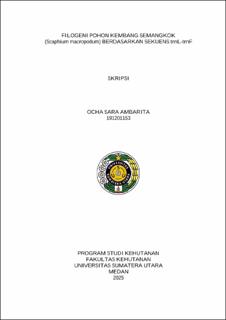| dc.description.abstract | Kembang semangkok (Scaphium macropodum) is a species that has experienced population decline due to a long fruiting cycle and habitat degradation. Although its current conservation status is of least concern (LC) according to the IUCN, the threat from deforestation and human disturbance remains a major concern. This study aims to analyze the kinship relationship of the kembang semangkok using phylogenetic methods based on the trnL-trnF gene sequence. This study was conducted using kembang semangkok sequence data and comparison sequence data and outgroup obtained from the NCBI database. The data was processed on MEGA 11 software to reconstruct phylogeny trees with 4 methods, namely UPGMA, Neighbor-Joining, Maximum Likehood, and Maximum Parsimony. The results of the juxtaposition carried out on 41 sequences obtained sequence length, which was 998 bp (basepair), conserved site value of 68.04%, variable site of 29.19%, and parsimony site of 20.04%. The phylogeny tree generated using the 4 methods shows that all Scaphium macropodum sequences are in a monophyletic group with a fairly good bootstrap value of between
96-100%.The results of the analysis show that the UPGMA (Unweight Pair Group Method with Arithmetic Average) method applied provides a more accurate picture of kinship relationships between species.
Kembang semangkok (Scaphium macropodum) is a species that has experienced population decline due to a long fruiting cycle and habitat degradation. Although its current conservation status is of least concern (LC) according to the IUCN, the threat from deforestation and human disturbance remains a major concern. This study aims to analyze the kinship relationship of the kembang semangkok using phylogenetic methods based on the trnL-trnF gene sequence. This study was conducted using kembang semangkok sequence data and comparison sequence data and outgroup obtained from the NCBI database. The data was processed on MEGA 11 software to reconstruct phylogeny trees with 4 methods, namely UPGMA, Neighbor-Joining, Maximum Likehood, and Maximum Parsimony. The results of the juxtaposition carried out on 41 sequences obtained sequence length, which was 998 bp (basepair), conserved site value of 68.04%, variable site of 29.19%, and parsimony site of 20.04%. The phylogeny tree generated using the 4 methods shows that all Scaphium macropodum sequences are in a monophyletic group with a fairly good bootstrap value of between
96-100%.The results of the analysis show that the UPGMA (Unweight Pair Group Method with Arithmetic Average) method applied provides a more accurate picture of kinship relationships between species. | en_US |


